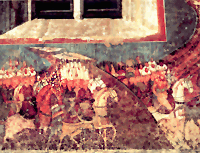 |
|
 |
The fall of Constantinople
 efore embarking on his systematic siege of the Byzantine capital, Mehmed II took care to cut it off on all sides. Following the construction of a fortress on the
efore embarking on his systematic siege of the Byzantine capital, Mehmed II took care to cut it off on all sides. Following the construction of a fortress on the
 Bosporos, he began, in the early part of 1453, to assemble troops in Adrianople. At the same time, he seized the cities on the Propontis and the Black Sea, with the exception of Selymbria. Bosporos, he began, in the early part of 1453, to assemble troops in Adrianople. At the same time, he seized the cities on the Propontis and the Black Sea, with the exception of Selymbria.
In early April 1453,
Mehmed II
began the tactical siege of Constantinople, which based its defence exclusively on its mighty walls and on a corps of 7,000 soldiers (5,000 Byzantines and 2,000 foreigners). It was reinforced by 700 Genoese soldiers under the command of
Giovanni Giustiniani. But the
strength of
the walls and the determination of its few defenders were not enough to save Byzantium, as the Turks had at their disposal an army of about 150,000 men and a powerful, technically advanced weaponry. Artillery was extensively used by the Turks - so much so that, as one Byzantine put it, "everything was decided by the cannon". After a fierce struggle lasting approximately seven weeks, the walls of the Byzantine capital began to show serious cracks.
Mehmed II decided to launch his final attack on 29
May 1453. On the eve of that date the Byzantines and the Latins held the last service of vespers in the church of Hagia Sophia. At dawn on 29 May 1453 Mehmed launched an attack from three sides. On the walls, the last Emperor of Byzantium fought heroically to the end, by the side of the other defenders of the city. There he was killed in the middle of the fray, as he himself had willed it. The "Queen of Cities", which had shone as a political and cultural centre of the world for eleven long centuries, fell with him. Then began an orgy of looting that lasted for three days and three nights, during which works of art and objects of beauty and inestimable value were destroyed forever. Mehmed II, mounted on his horse, made his triumphal entry into what was now the capital of the Ottoman Empire. Byzantium was no more.
|